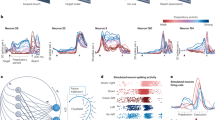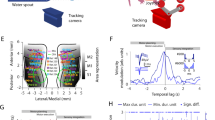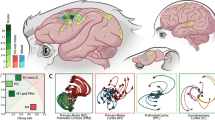Abstract
Most theories of motor cortex have assumed that neural activity represents movement parameters. This view derives from what is known about primary visual cortex, where neural activity represents patterns of light. Yet it is unclear how well the analogy between motor and visual cortex holds. Single-neuron responses in motor cortex are complex, and there is marked disagreement regarding which movement parameters are represented. A better analogy might be with other motor systems, where a common principle is rhythmic neural activity. Here we find that motor cortex responses during reaching contain a brief but strong oscillatory component, something quite unexpected for a non-periodic behaviour. Oscillation amplitude and phase followed naturally from the preparatory state, suggesting a mechanistic role for preparatory neural activity. These results demonstrate an unexpected yet surprisingly simple structure in the population response. This underlying structure explains many of the confusing features of individual neural responses.
This is a preview of subscription content, access via your institution
Access options
Subscribe to this journal
Receive 51 print issues and online access
$199.00 per year
only $3.90 per issue
Buy this article
- Purchase on Springer Link
- Instant access to full article PDF
Prices may be subject to local taxes which are calculated during checkout






Similar content being viewed by others
References
Lemon, R. N. An enduring map of the motor cortex. Exp. Physiol. 93, 798–802 (2008)
Evarts, E. V. Relation of pyramidal tract activity to force exerted during voluntary movement. J. Neurophysiol. 31, 14–27 (1968)
Mussa-Ivaldi, F. A. Do neurons in the motor cortex encode movement direction? An alternative hypothesis. Neurosci. Lett. 91, 106–111 (1988)
Fetz, E. E. Are movement parameters recognizably coded in the activity of single neurons? Behav. Brain Sci. 15, 679–690 (1992)
Sanger, T. D. Theoretical considerations for the analysis of population coding in motor cortex. Neural Comput. 6, 29–37 (1994)
Todorov, E. Direct cortical control of muscle activation in voluntary arm movements: a model. Nature Neurosci. 3, 391–398 (2000)
Hatsopoulos, N. G. Encoding in the motor cortex: was Evarts right after all? Focus on “motor cortex neural correlates of output kinematics and kinetics during isometric-force and arm-reaching tasks”. J. Neurophysiol. 94, 2261–2262 (2005)
Scott, S. H. Inconvenient truths about neural processing in primary motor cortex. J. Physiol. (Lond.) 586, 1217–1224 (2008)
Morrow, M. M., Pohlmeyer, E. A. & Miller, L. E. Control of muscle synergies by cortical ensembles . Adv. Exp. Med. Biol. 629, 179–199 (2009)
Aflalo, T. N. & Graziano, M. S. A. Relationship between unconstrained arm movements and single-neuron firing in the macaque motor cortex. J. Neurosci. 27, 2760–2780 (2007)
Kalaska, J. F. From intention to action: motor cortex and the control of reaching movements. Adv. Exp. Med. Biol. 629, 139–178 (2009)
Georgopoulos, A. P., Schwartz, A. B. & Kettner, R. E. Neuronal population coding of movement direction. Science 233, 1416–1419 (1986)
Kakei, S., Hoffman, D. S. & Strick, P. L. Muscle and movement representations in the primary motor cortex. Science 285, 2136–2139 (1999)
Churchland, M. M. & Shenoy, K. V. Temporal complexity and heterogeneity of single-neuron activity in premotor and motor cortex. J. Neurophysiol. 97, 4235–4257 (2007)
Churchland, M. M., Cunningham, J. P., Kaufman, M. T., Ryu, S. I. & Shenoy, K. V. Cortical preparatory activity: representation of movement or first cog in a dynamical machine? Neuron 68, 387–400 (2010)
Todorov, E. & Jordan, M. I. Optimal feedback control as a theory of motor coordination. Nature Neurosci. 5, 1226–1235 (2002)
Graziano, M. S. New insights into motor cortex. Neuron 71, 387–388 (2011)
Churchland, M. M., Santhanam, G. & Shenoy, K. V. Preparatory activity in premotor and motor cortex reflects the speed of the upcoming reach. J. Neurophysiol. 96, 3130–3146 (2006)
Cisek, P. Preparing for speed. Focus on: “preparatory activity in premotor and motor cortex reflects the speed of the upcoming reach”. J. Neurophysiol. 96, 2842–2843 (2006)
Georgopoulos, A. P. & Grillner, S. Visuomotor coordination in reaching and locomotion. Science 245, 1209–1210 (1989)
Grillner, S. Biological pattern generation: the cellular and computational logic of networks in motion. Neuron 52, 751–766 (2006)
Rokni, U. & Sompolinsky, H. How the brain generates movement. Neural Comput. 24, 289–331 (2011)
Kristan, W. B., Jr & Calabrese, R. L. Rhythmic swimming activity in neurones of the isolated nerve cord of the leech. J. Exp. Biol. 65, 643–668 (1976)
Briggman, K. L. & Kristan, W. B., Jr Imaging dedicated and multifunctional neural circuits generating distinct behaviors. J. Neurosci. 26, 10925–10933 (2006)
Briggman, K. L., Abarbanel, H. D. & Kristan, W. B., Jr Optical imaging of neuronal populations during decision-making. Science 307, 896–901 (2005)
Shenoy, K. V., Kaufman, M. T., Sahani, M. & Churchland, M. M. in Progress in Brain Research: Enhancing Performance for Action and Perception (eds Green, A., Chapman, E., Kalaska, J. F. & Lepore, F. ) (Elsevier, 2011)
Moran, D. W. & Schwartz, A. B. Motor cortical representation of speed and direction during reaching. J. Neurophysiol. 82, 2676–2692 (1999)
Messier, J. & Kalaska, J. F. Covariation of primate dorsal premotor cell activity with direction and amplitude during a memorized-delay reaching task. J. Neurophysiol. 84, 152–165 (2000)
Kaufman, M. T. et al. Roles of monkey premotor neuron classes in movement preparation and execution. J. Neurophysiol. 104, 799–810 (2010)
Sergio, L. E., Hamel-Paquet, C. & Kalaska, J. F. Motor cortex neural correlates of output kinematics and kinetics during isometric-force and arm-reaching tasks. J. Neurophysiol. 94, 2353–2378 (2005)
Llinas, R. I of the Vortex (MIT Press, 2002)
Yuste, R., MacLean, J. N., Smith, J. & Lansner, A. The cortex as a central pattern generator. Nature Rev. Neurosci. 6, 477–483 (2005)
Yakovenko, S., Krouchev, N. & Drew, T. Sequential activation of motor cortical neurons contributes to intralimb coordination during reaching in the cat by modulating muscle synergies. J. Neurophysiol. 105, 388–409 (2011)
Middleton, F. A. & Strick, P. L. Basal ganglia and cerebellar loops: motor and cognitive circuits. Brain Res. Brain Res. Rev. 31, 236–250 (2000)
Thorn, C. A., Atallah, H., Howe, M. & Graybiel, A. M. Differential dynamics of activity changes in dorsolateral and dorsomedial striatal loops during learning. Neuron 66, 781–795 (2010)
Herter, T. M., Korbel, T. & Scott, S. H. Comparison of neural responses in primary motor cortex to transient and continuous loads during posture. J. Neurophysiol. 101, 150–163 (2008)
Sussillo, D. & Abbott, L. F. Generating coherent patterns of activity from chaotic neural networks. Neuron 63, 544–557 (2009)
Scott, S. H. Optimal feedback control and the neural basis of volitional motor control. Nature Rev. Neurosci. 5, 532–546 (2004)
Gilja, V., Chestek, C. A., Nuyujukian, P., Foster, J. D. & Shenoy, K. V. Autonomous head-mounted electrophysiology systems for freely behaving primates. Curr. Opin. Neurobiol. 20, 676–686 (2010)
Foster, J. D. et al. in Proc. of the 5th International IEEE EMBS Conference on Neural Engineering 613–615 (IEEE, 2011)
Miranda, H. et al. A high-rate long-range wireless transmission system for simultaneous multichannel neural recording applications. IEEE Trans. Biomed. Circ. Syst. 4, 181–191 (2010)
Churchland, M. M., Yu, B. M., Ryu, S. I., Santhanam, G. & Shenoy, K. V. Neural variability in premotor cortex provides a signature of motor preparation. J. Neurosci. 26, 3697–3712 (2006)
Acknowledgements
We are deeply grateful to K. Briggman and W. Kristan for providing data recorded from the leech. We thank M. Risch for animal care, S. Eisensee for administrative support, and D. Haven and B. Oskotsky for information technology support. We thank Z. Ghahramani and C. Rasmussen for discussion of jPCA and related methods. We thank D. Sussillo, S. Grossman and M. Sahani for analysis suggestions and commentary on the manuscript. This work was supported by a Helen Hay Whitney postdoctoral fellowship and National Institutes of Health (NIH) postdoctoral training fellowship (M.M.C.), the Burroughs Wellcome Fund Career Awards in the Biomedical Sciences (M.M.C., K.V.S.), Engineering and Physical Sciences Research Council grant EP/H019472/1 and the McDonnell Center (J.P.C.), a National Science Foundation graduate research fellowship (M.T.K.), a Texas Instruments Stanford Graduate Fellowship (J.D.F.), a Paul and Daisy Soros Fellowship (P.N.), the Stanford Medical Scientist Training Program (P.N.), and these awards to K.V.S.: NIH Director’s Pioneer Award (1DP1OD006409), NIH NINDS EUREKA Award (R01-NS066311), NIH NINDS BRP (R01-NS064318), NIH NINDS CRCNS (R01-NS054283), DARPA-DSO REPAIR (N66001-10-C-2010), Stanford Center for Integrated Systems, NSF Center for Neuromorphic Systems Engineering at Caltech, Office of Naval Research, and the Whitaker Foundation, the McKnight Foundation, the Sloan Foundation and the Weston Havens Foundation.
Author information
Authors and Affiliations
Contributions
The jPCA method was designed by J.P.C. and M.M.C. M.M.C. and M.T.K. collected data from the reaching monkeys. J.D.F. and P.N. collected data from the walking monkey. S.I.R. led the array implantation surgeries. K.V.S. contributed to all aspects of the work. All authors discussed the results and commented on the analyses and manuscript.
Corresponding author
Ethics declarations
Competing interests
The authors declare no competing financial interests.
Supplementary information
Supplementary Information
This file contains Supplementary Figures 1-11, Supplementary Text and Data, legends for Supplementary Movies 1-5 and additional references. (PDF 2272 kb)
Supplementary Movie 1
This move shows the neural trajectory in the walking monkey (2× real time) - see Supplementary Information file for full legend. (MOV 367 kb)
Supplementary Movie 2
This movie Illustrates how the PCA axes were rotated to find the jPCA projection - see Supplementary Information file for full legend. (MOV 3066 kb)
Supplementary Movie 3
This movie shows the jPCA projections as a function of time - see Supplementary Information file for full legend. (MOV 2378 kb)
Supplementary Movie 4
This movie shows the jPCA projections as a function of time after applying the shuffle control - see Supplementary Information file for full legend. (MOV 1793 kb)
Supplementary Movie 5
This movie shows the jPCA projections as a function of time for populations of muscle recordings - see Supplementary Information file for full legend. (MOV 1150 kb)
Rights and permissions
About this article
Cite this article
Churchland, M., Cunningham, J., Kaufman, M. et al. Neural population dynamics during reaching. Nature 487, 51–56 (2012). https://doi.org/10.1038/nature11129
Received:
Accepted:
Published:
Issue Date:
DOI: https://doi.org/10.1038/nature11129
This article is cited by
-
Temporal scaling of motor cortical dynamics reveals hierarchical control of vocal production
Nature Neuroscience (2024)
-
Latent neural population dynamics underlying breathing, opioid-induced respiratory depression and gasping
Nature Neuroscience (2024)
-
Neurobiologically realistic neural network enables cross-scale modeling of neural dynamics
Scientific Reports (2024)
-
Neuronal travelling waves explain rotational dynamics in experimental datasets and modelling
Scientific Reports (2024)
-
Dataset of human-single neuron activity during a Sternberg working memory task
Scientific Data (2024)
Comments
By submitting a comment you agree to abide by our Terms and Community Guidelines. If you find something abusive or that does not comply with our terms or guidelines please flag it as inappropriate.



